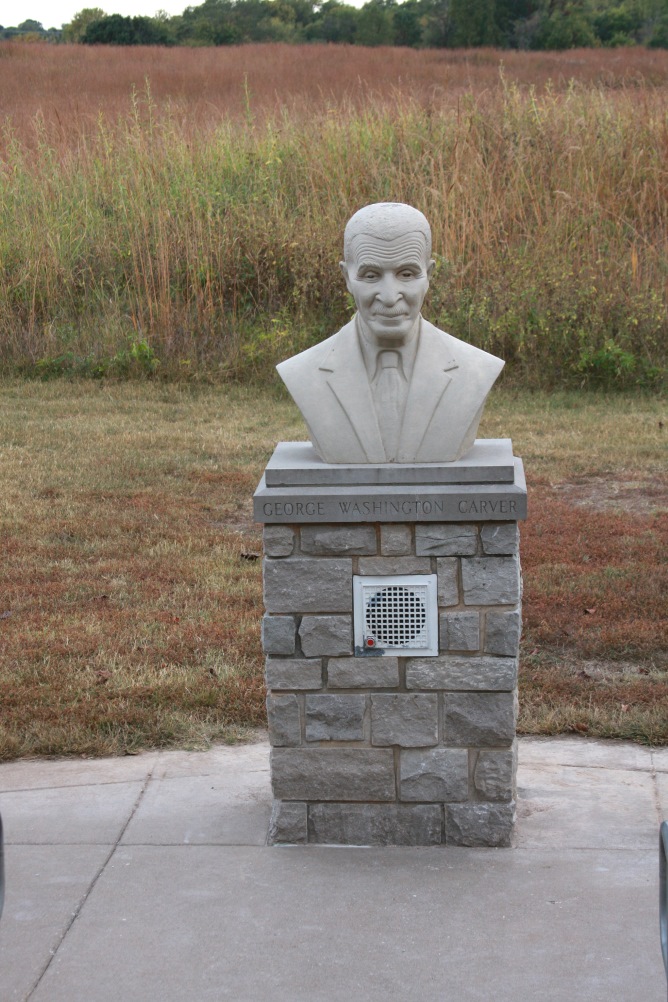October 5, 2022 @ 15:50 CST
Site Visit #53
I tried a unique “triple-header” today! Wilson’s Creek National Battlefield, Pea Ridge National Military Park, and George Washington Carver National Monument are located in a triangle, each about one hour apart. Wilson’s Creek opens at 8:00 rather than the more common 9:00, so I figured with two hours at each site, I could pull this off.
Well, almost. Of course, I spent a little more time at the first two than I expected, and with traffic, it took a little longer between the sites. Nonetheless, I arrived at George Washington Carver National Monument shortly before 4:00, giving me one hour before the gate would close and lock my car inside!
I was interested in finding out why the George Washington Carver National Memorial (GWCNM) was located outside of Joplin in southwestern Missouri, as Carver was best known for his work at the Tuskegee Institute in Alabama.
The answer, it turns out, was that this is where he was born in 1864. I was too late in the day to visit the house that sat some distance from the visitors center, but actually had little interest in doing so. Carver was born a slave to the homeowners, not a resident.
Some may ask how he and his mother (he never knew his father) could be slaves in 1864 given that the Emancipation Proclamation was issued on January 1, 1863. The Proclamation only declared slaves to be free in states under rebellion, and since Missouri had stayed in the Union, slavery remained legal until it was abolished nationwide after the war ended.

In this rare case, I won’t judge the slaveowners (the Carvers, who gave George his last name) too harshly. Shortly after Carver was born, outlaws kidnapped his mother and him. The Carvers sought the two and found George in Arkansas. Sadly, his mother was never located. George was returned to the Carvers and raised by them.
He developed a love of nature growing up here, and a thirst for knowledge, but even after the Civil War, a black child was more often denied entrance to the local schools. At the young age of 11, he decided to leave this home, traveling first to Kansas, where he was able to get into a school.
I tried to think back to when I was 11 (a looong time ago) and imagine striking out on my own. No way that would happen!
His struggles continued as he desired a university education. His travels brought him to the small town of Winterset, Iowa, where he stayed a short time until he was finally accepted at nearby Simpson College. (Side note about Winterset: in addition to being a home for Carver, it was the birthplace of John Wayne, and as the county seat of Madison County, has some famous covered bridges around it).
At Simpson, he was majoring in art but felt his calling was in agriculture. He transferred to nearby Iowa State University where he gained both a Bachelor’s and Master’s Degree in Agriculture. This caught the attention of Booker T. Washington, who invited Carver to join the Tuskegee Institute. It was here where Carver excelled in his field, teaching new farming techniques to increase yields, along with his famous peanut research. He eventually found himself testifying before the U.S. Congress.
The mostly racist southern Congressmen on the committee before which he spoke initially dismissed him and his comments. But as his testimony continued, his knowledge and clarity even gained respect from those representatives
Sadly, even his fame could not overcome the discrimination he experienced. On many occasions, even in the north, Carver would be invited to be a main speaker at some event but forced to use the “servants” entrance to the venue. That he would endure this humiliation so that he could promote his passion says a lot about him.
Steve